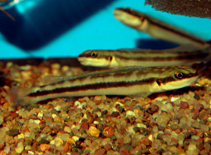| Diagnosis: |
Dorsal spines (total): 22-24; Dorsal soft rays (total): 8-10; Anal spines: 2-4; Anal soft rays: 8-10; Vertebrae: 33-35. Diagnosis: upper jaw moderately protrusible; groove between upper jaw and snout "normal" for Cichlidae, continuous around snout and moderately deep; snout tip not visible from below; body vertically oval in cross-section; squamation relatively only slightly reduced; Tilapia mark on soft dorsal present in juveniles and adults (Ref. 53766).
Description: body elongated (Ref. 3032, 53780), slightly compressed (Ref. 53780). Head slightly depressed; upper jaw in advance of lower jaw (Ref. 53780). Lips well developed (Ref. 2756, 53781). Maxillary extends beyond vertical from nostrils (Ref. 2756, 53780). Outer jaw teeth bicuspid, inner jaw teeth tricuspid, posterior pharyngeal jaw teeth monocuspid (Ref. 53405). Eye supralateral (Ref. 2756), not visible from below (Ref. 53780). Gill membranes united, free from isthmus (Ref. 53780). No microbranchiospines (Ref. 53405). Scales cycloid or ctenoid (Ref. 2756, 3032, 7378, 53405, 53780). Scales behind pectoral fins with little, more or less well developed denticulations; scales equal-sized in caudal region, becoming smaller towards back and belly; belly and head naked, except for a few scales on opercle and preopercle (Ref. 2756, 7378, 53405, 53780). At least 3 scales between lateral line and posterior part of dorsal fin, 6 scales between first soft ray of dorsal fin and lateral line, and 10 scales between origin of anal fin and lateral line; first dorsal fin spine small, last spine longest; soft dorsal rays longer than dorsal fin spines (Ref. 53780). Dorsal fin origin above pectoral fin base (Ref. 2756). Longest soft rays extend beyond caudal fin origin (Ref. 2756, 53781). Dorsal fin lappets small and probably unconspicuous in life (Ref. 53766). Pectoral fin rounded; pelvic fin inserted under pectoral fin; median soft ray of pelvic fins longer than other soft rays (Ref. 2756). Anal fin short (Ref. 53780). Caudal fin rounded (Ref. 2756, 53780, 53781). Caudal fin with 14 soft rays (Ref. 53780).
Coloration: in life: body greenish, lighter on belly; dark longitudinal band along middle of flanks (Ref. 2756, 3032, 7378, 53405, 53781) that runs into head, below eye, and directly into upper lips (Ref. 52307). An irregular band is present directly under dorsal fin (Ref. 52307). 5-6 alternating light and dark vertical bands between lateral line and back, particularly distinct in juveniles (Ref. 2756, 7378, 53405). Upper margin of dorsal and caudal fin sometimes red (Ref. 2756, 3032, 7378, 53405, 53781). Base of soft dorsal fin with "tilapia" mark (Ref. 2756, 3032, 7378, 31256, 52307, 53405, 53781). Black spot on operculum (Ref. 2756, 3032, 53781). During their first weeks of life, juveniles exhibit several dark vertical bars on the body; territorial individuals appear dark gray to blackish when breeding (Ref. 52307). Preserved specimens (alcohol): body brown; dusky irregular longitudinal stripe along middle of side from head to caudal fin; narrower longitudinal stripe from head along base of spinous dorsal to soft dorsal fin; dorsal fin dusky, paler along outer edge widening to include distal half of soft dorsal fin; dark blotch on opercle, on base of soft dorsal and on base of caudal fin (Ref. 53780). |

